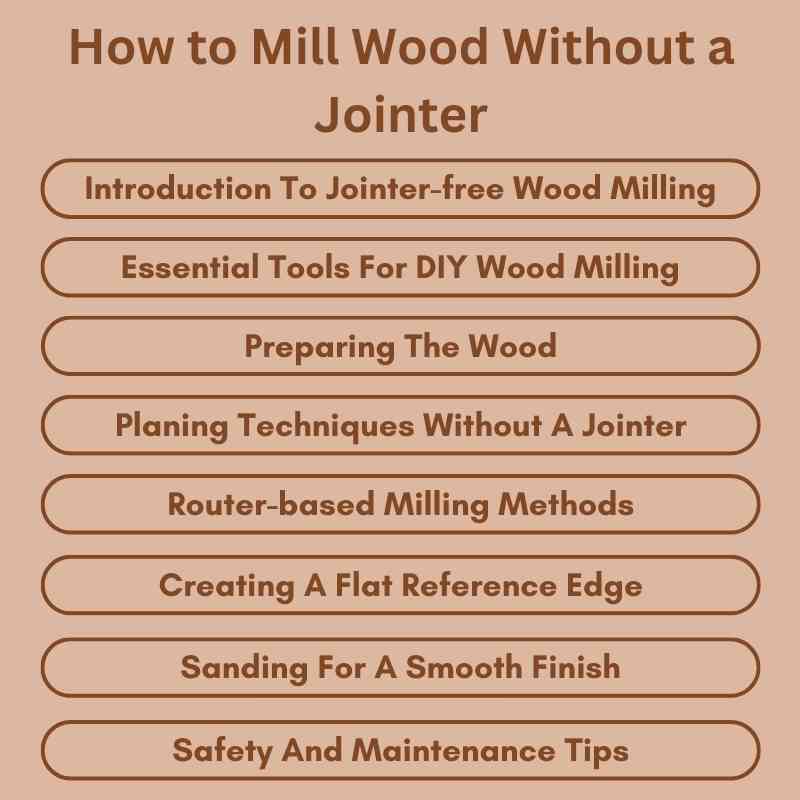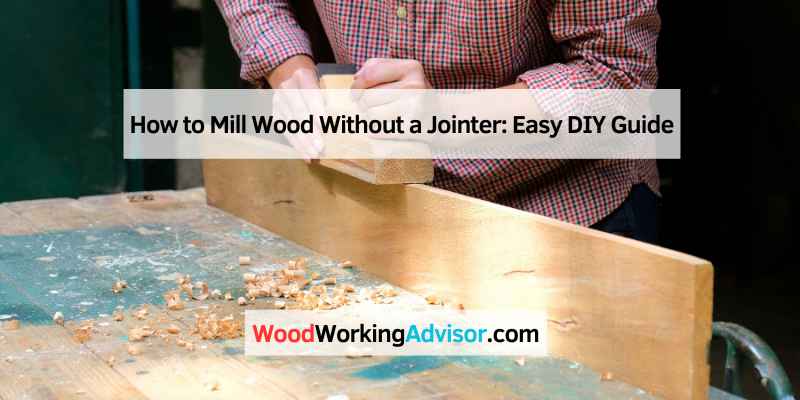To mill wood without a jointer, use a circular saw and a straight edge to create a flat edge. Alternatively, employ a hand plane for smaller adjustments.
Milling wood without a jointer can seem challenging, but it’s entirely feasible with the right tools. Many woodworkers face this issue, especially beginners or those working in smaller shops. A jointer is often essential for achieving flat surfaces and square edges, but other methods can deliver similar results.
Using tools like a circular saw, hand plane, or even a router can help you achieve a smooth finish. This guide will explore these techniques, ensuring you get the most out of your woodworking projects without relying on a jointer. Embrace creativity and resourcefulness to transform your lumber effectively.
Introduction To Jointer-free Wood Milling
Creating flat surfaces is essential for woodworking projects. A smooth surface helps pieces fit together well. This ensures a strong and stable final product.
Many people think a jointer is necessary. There are several effective alternatives to achieve flat surfaces without one:
- Hand Planes: Use a hand plane to shave off uneven spots.
- Router: A router can flatten wood with a jig.
- Sanders: An orbital sander smooths surfaces effectively.
- Table Saw: A table saw can help create straight edges.
Utilizing these methods allows for versatile woodworking. Experimenting with different tools will help improve your skills.

Essential Tools For DIY Wood Milling
Choosing the right hand planes is crucial for effective wood milling. A block plane works well for smoothing edges. A jack plane is perfect for flattening surfaces.
A router can serve as a great substitute for a jointer. Using a router allows for precise edge shaping. Make sure to secure the wood properly while routing.
| Tool | Use |
|---|---|
| Hand Plane | Smoothing and flattening wood surfaces |
| Router | Edge shaping and jointing |
| Straightedge | Guiding cuts for accuracy |
| Clamps | Securing wood during milling |
Using straightedges and clamps helps maintain accuracy. Straightedges guide saw cuts to keep lines straight. Clamps hold wood firmly while you work.
Preparing The Wood
Start by inspecting the wood carefully. Check for warps and twists. These defects can affect the milling process. Look at the edges and surfaces closely. A flat surface is essential for good results.
Next, mark the high spots that need removal. Use a pencil to make clear marks. This helps to focus on areas needing attention. Remove material from these spots gradually. Keep checking the flatness as you work.
Consider using a straight edge for better accuracy. This tool helps to ensure your marks are precise. Proper preparation leads to a better milling experience. Always take your time during this step for the best outcome.
Planing Techniques Without A Jointer
Face-planing wood can be done effectively without a jointer. Start by placing the rough side of the wood down. Use a hand plane to smooth out the surface. Keep the plane flat and apply even pressure. Work from one end to the other for best results.
Edge-planing ensures that your wood is straight. Clamp the wood securely to a stable surface. Use a straight edge as a guide. Move the hand plane along the edge, applying light pressure. Check the straightness often to avoid mistakes.
Using these techniques helps create smooth and straight wood surfaces. Remember to practice for better results. Patience is key to achieving a professional finish.
Router-based Milling Methods
Setting up a router table is easy and fun. First, choose a sturdy workbench. Make sure the table is at a comfortable height. Secure the router in the table. Adjust the bit height for the desired cut.
Using a router jig can help in flattening wood. Create a simple jig using plywood. Attach rails to guide the router. This setup helps achieve a flat surface quickly.
| Step | Description |
|---|---|
| 1 | Choose a stable workbench. |
| 2 | Securely mount the router. |
| 3 | Set the bit height carefully. |
| 4 | Make a plywood jig with rails. |
Creating A Flat Reference Edge
Creating a flat reference edge is important for woodworking. A straightedge guide helps achieve this easily. Use a long, straight board as your guide. Clamp it securely to your workpiece.
Mark a line on your wood to follow. Cut along this line carefully. This method ensures a straight edge without a jointer.
Using hand tools like a hand plane can also help. A hand plane smooths the edge perfectly. Keep the plane sharp for the best results.
Take small, even strokes for better control. Check your progress frequently to maintain accuracy. A flat edge is key for precise woodworking.
Sanding For A Smooth Finish
Choosing the right grit is important for a smooth finish. Start with a coarser grit, like 80. This helps remove any rough spots quickly. After that, move to a medium grit, such as 120. This will smooth the surface further.
Finally, finish with a fine grit, like 220. This gives the wood a polished look. Always sand in the direction of the grain. This prevents scratches and enhances the wood’s beauty.
| Grit Type | Purpose |
|---|---|
| 80 | Remove rough spots |
| 120 | Smooth the surface |
| 220 | Polish the wood |
Progressive sanding techniques are key for great results. Always check the surface after each grit. This ensures the wood is smooth and ready for finishing. Patience is important during this process.
Safety And Maintenance Tips
Safety is key when using tools. Always wear protective gear like goggles and gloves. Keep your workspace clean to avoid accidents. Always follow the manufacturer’s instructions for each tool.
Proper handling of tools is essential. Hold tools firmly and use both hands when possible. Maintain a stable stance to prevent falls.
Keeping blades sharp ensures better cuts. Dull blades can cause accidents and less precise work. Regularly check and sharpen blades as needed.
Dust can create hazards in your workspace. Use a dust mask to protect your lungs. Set up a dust collection system for cleaner air.
| Tip | Description |
|---|---|
| Protective Gear | Wear goggles, gloves, and a mask. |
| Tool Handling | Always use both hands and stand firmly. |
| Blade Maintenance | Regularly check for sharpness and clean. |
| Dust Control | Use masks and set up dust collection. |
Troubleshooting Common Issues
Dealing with snipe can be a common problem. Snipe occurs at the start or end of boards. To reduce this issue, support the wood well during milling. Use rollers or other supports to keep it steady.
Another way to minimize snipe is to feed the wood slowly. This allows the machine to work better. Always check the depth of cut. A lighter cut can help prevent snipe.
Avoiding uneven thickness is also essential. Always measure the thickness before milling. If the wood is warped, flatten one side first. This creates a stable base for further milling.
Regularly check your equipment. Sharp blades can make a big difference. Dull blades cause more problems and lead to uneven surfaces.
Final Thoughts
The satisfaction of DIY milling is hard to beat. It brings a sense of accomplishment and creativity. Each board you mill reflects your effort and skill. Watching raw wood transform into a beautiful piece is truly rewarding.
Continuously improving your skills is essential. Experiment with different techniques and tools. Each project teaches something new. Embrace mistakes as learning opportunities. The more you practice, the better you will become.
Join a community of DIY enthusiasts. Share your experiences and tips with others. Learning from fellow makers can inspire new ideas. Remember, every expert was once a beginner.

Frequently Asked Questions
How Can I Mill Wood Without A Jointer?
You can mill wood without a jointer by using a table saw or a hand plane. A table saw can create a flat edge if set up correctly. Alternatively, a hand plane can smooth edges effectively. Both methods provide precision without needing a jointer.
What Tools Do I Need For Milling Wood?
Essential tools for milling wood include a table saw, circular saw, and hand plane. A straightedge is also helpful for guiding cuts. Additionally, clamps can secure your wood while you work. These tools will help you achieve flat, smooth surfaces.
Is It Possible To Use A Router For Milling?
Yes, a router can be used for milling wood. It helps create flat surfaces and clean edges. By using a straight bit and a guide, you can achieve excellent results. This method is effective for smaller projects where precision is crucial.
Can I Mill Wood With A Circular Saw?
Absolutely! A circular saw is a versatile tool for milling wood. By using a straightedge as a guide, you can make accurate cuts. This method is especially useful for larger pieces of wood. Always ensure your cuts are straight for the best results.
Conclusion
Milling wood without a jointer is entirely feasible with the right techniques. By using simple tools and methods, you can achieve flat, smooth surfaces. Embrace creativity and experiment with different approaches. With practice, you’ll master this skill, enhancing your woodworking projects.
Start your journey today and enjoy the satisfaction of self-sufficiency.

